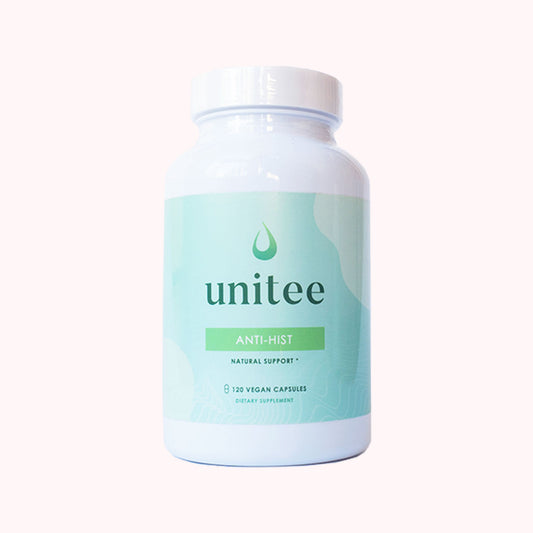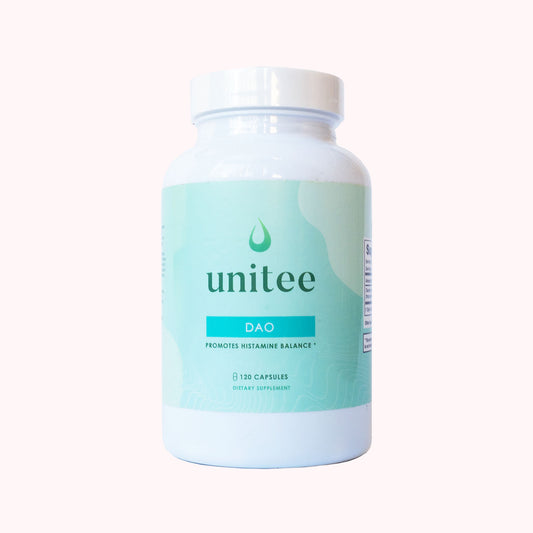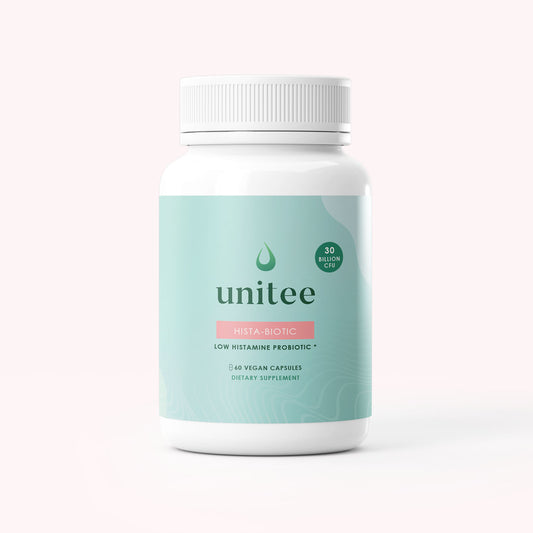If you’ve been suffering from histamine intolerance, and reacting to foods with outbreaks of symptoms such as hives, skin rashes and digestive symptoms, you’re probably wondering how you got here and what causes histamine intolerance in the first place.
Addressing the topic of what causes histamine intolerance is a big one, so I’m going to make this as clear and succinct as possible to maximize your understanding.
What Exactly Is Histamine Intolerance?
Overall, histamine intolerance comes down to a combination of two things:
- There's an imbalance in your internal histamine levels; and
- Your body is not able to function optimally at the levels that histamine are at.
Basically, the histamine levels in your body are at a level that is bothersome to the body. We would often consider this as being something as obvious as them being too high, but this is not always the case. In fact, sometimes histamine levels are within the normal range in those who are living with histamine intolerance. The trouble is, these levels, despite being normal, are still not well tolerated for any given reason (1).
And, much like the processes that occur in the body during an allergic reaction, these intolerable levels of histamine are causing a response that you’re experiencing as histamine intolerance symptoms (2).
Although many factors contribute to what your internal histamine levels are, in my clinical practice, there are 4 major factors involved I would target when it comes to the underlying cause of histamine intolerance.
There Are Four Main Causes of Histamine Intolerance
When it comes to the levels on histamine in your body, these four factors are usually the main contributors:
-
What you eat, drink, and are exposed to in your environment may play a role in increasing your histamine levels. Histamine that enters through the digestive system is consumed mainly through food and drink, but you can also be exposed to increased levels of histamine through environmental and plant exposures. The histamines obtained from your diet usually comes from food that either contains histamine itself, causes your body to liberate more histamine, or it has its own set of enzymes that stops your body from optimally breaking histamine down in the first place. Environmental exposure usually follows the latter two patterns that food does; causing histamine to be released within the body, and stopping the body from breaking it down. For this reason, one of the first things I always suggest when it comes to a quick way to begin to manage the histamine levels in the body, is to start following a low histamine diet (3).
-
The trillions of bacteria that populate your body have the capacity to control your histamine levels. Your body is populated with an extensive amount of bacteria and they have the ability to increase or decrease your histamine levels. Some bacteria produce histamine by converting the amino acid histidine into histamine. Other bacteria may be able to help to manage your histamine levels by degrading it. Often, when people are living with histamine intolerance, these histamine-degrading bacteria are in lower amounts, or they're not able to grow in your body's environment at all. And with poor digestive health, many people will add probiotics to help, but they actually end up causing more harm. Why? Many of the probiotics combinations that are readily available for sale actually contribute to higher histamine levels because of the composition of bacteria in the products. These formulas are generally helpful to most people, however, because they contain histamine-producing bacteria, they're extremely bothersome if you have histamine intolerance. When looking for a probiotic, I always recommend you ensure you are taking a histamine safe option. This is one I have formulated to contain only helpful bacteria for histamine intolerance, and none of the species that produce more histamine (4).
-
Your histamine-containing cells may be releasing more histamine than they should. Histamine is typically produced and stored in high amounts in two main immune cells: mast cells and basophils (5). When the body is in trouble, they're activated as part of the immune processes in response to allergens or foreign invaders in the body. However, if there are no foreign invaders, but the immune system has started to react to normal compounds in the body, seeing them as a threat, mast cells and basophils will begin to release more histamine, which contributes to higher-than-normal levels.
-
The enzymes you need to degrade histamine may not be functioning optimally; or at all! Histamine is degraded by specialized histamine degrading enzymes such as diamine oxidase (DAO) and histamine N-methyltransferase (HNMT) (6). Low levels of these enzymes due to genetic or other factors can result in a slower-than-normal rate of histamine degradation. While we're not able to target the genes responsible for making these enzymes, DAO is something we can alter, especially the levels that are needed to break down histamine in the gut. Those who need a little more support from the enzyme side of things often find relief by adding an all-natural DAO enzyme supplement to their routine.
As you can see, histamine intolerance can be caused and exacerbated by a variety of factors. There's usually one more factor to consider, and that's the health of the digestive system.
The Health of the Digestive System Is Important to Consider When Dealing With Histamine Intolerance
In a perfect digestive system, the levels of histamine consumption, production and release will balance with the levels of histamine degradation.
However... in a compromised digestive system, such as is seen in people with Irritable Bowel Syndrome (IBS), Inflammatory Bowel Disease (IBD), or other gut-related issues, factors such as bacterial imbalances and enzyme insufficiencies can throw off the way that the body is able to regulate histamine levels, resulting histamines that are out of the tolerable range.
These intolerable histamine levels can cause inflammation that can go on to impact how the digestive system functions, producing or exacerbating digestive issues and causing food sensitivities, which induce histamine release (7).
In addition to digestive upset and symptoms, all of these factors combined may be behind the development of all of your seemingly unrelated symptoms such as skin rashes, headaches, fatigue, respiratory symptoms or even symptoms that mimic allergic responses like hives and congestion.
Of course, it is important to remember that it's not always high levels of histamine that are bothersome. All of the above mentioned causes and factors can cause problems for some even when histamine is within normal ranges. This normal range may still not be tolerated, and symptoms develop as a result.
Getting Histamine Intolerance Symptoms Under Control
Although the list of what causes histamine intolerance can be a seemingly scary one, the good news is that histamine intolerance symptoms can actually be pretty easy to get under control.
By simply eliminating high histamine foods and focusing on a diet primarily composed of low histamine foods, you significantly reduce a major source of incoming histamine, therefore helping to balance total histamine levels in your body.
The other good (or should I say great) news is that following a low histamine diet has shown to work very quickly to alleviate symptoms, regardless of what is causing your histamine intolerance in particular.
Several studies have shown that histamine intolerant individuals will begin experiencing reductions in symptoms within 1-2 weeks of starting a low histamine diet (8).
As mentioned above, it's possible to further support your body's ability to tolerate histamine by adding a low histamine probiotic as well as a DAO enzyme to your routine.
Now that you know some of the major causes of your histamine intolerance, you're more likely to be able to put steps in place to support your body's overall levels; and more importantly, your tolerance to them!
References:
- Latorre-Moratalla ML, Comas-Basté O, Bover-Cid S, Vidal-Carou MC. Tyramine and histamine risk assessment related to consumption of dry fermented sausages by the Spanish population. Food Chem Toxicol. 2017;99:78-85. doi:10.1016/j.fct.2016.11.011
- Zhao Y, Zhang X, Jin H, Chen L, Ji J, Zhang Z. Histamine Intolerance-A Kind of Pseudoallergic Reaction. Biomolecules. 2022;12(3):454. Published 2022 Mar 15. doi:10.3390/biom12030454
- Comas-Basté O, Sánchez-Pérez S, Veciana-Nogués MT, Latorre-Moratalla M, Vidal-Carou MDC. Histamine Intolerance: The Current State of the Art. Biomolecules. 2020;10(8):1181. Published 2020 Aug 14. doi:10.3390/biom10081181
- Sánchez-Pérez S, Comas-Basté O, Duelo A, et al. Intestinal Dysbiosis in Patients with Histamine Intolerance. Nutrients. 2022;14(9):1774. Published 2022 Apr 23. doi:10.3390/nu14091774
- Panula P, Chazot PL, Cowart M, et al. International Union of Basic and Clinical Pharmacology. XCVIII. Histamine Receptors. Pharmacol Rev. 2015;67(3):601-655. doi:10.1124/pr.114.010249
- Comas-Basté O, Latorre-Moratalla ML, Bernacchia R, Veciana-Nogués MT, Vidal-Carou MC. New approach for the diagnosis of histamine intolerance based on the determination of histamine and methylhistamine in urine. J Pharm Biomed Anal. 2017;145:379-385. doi:10.1016/j.jpba.2017.06.029
-
Schnedl WJ, Enko D. Histamine Intolerance Originates in the Gut. Nutrients. 2021;13(4):1262. Published 2021 Apr 12. doi:10.3390/nu13041262
- Sánchez-Pérez S, Comas-Basté O, Veciana-Nogués MT, Latorre-Moratalla ML, Vidal-Carou MC. Low-Histamine Diets: Is the Exclusion of Foods Justified by Their Histamine Content? Nutrients. 2021;13(5):1395. Published 2021 Apr 21. doi:10.3390/nu13051395

Anita Tee
My name is Anita Tee. I'm a nutritional scientist who specializes in histamine intolerance. I hold a Master of Science in Personalized Nutrition and a Bachelor of Science in Human Biology and Psychology.
For the past ten years, I have used my experience in nutritional and medical health sciences to create a scientifically backed, natural approach to healthcare that relies 100% on evidence-based research.
As I previously suffered from - and overcame - histamine intolerance, my focus is to increase recognition and expand the available resources and protocols available for resolving this particular disorder. To date, I have helped over 4,000 individuals fully resolve or better manage their histamine intolerance symptoms.







